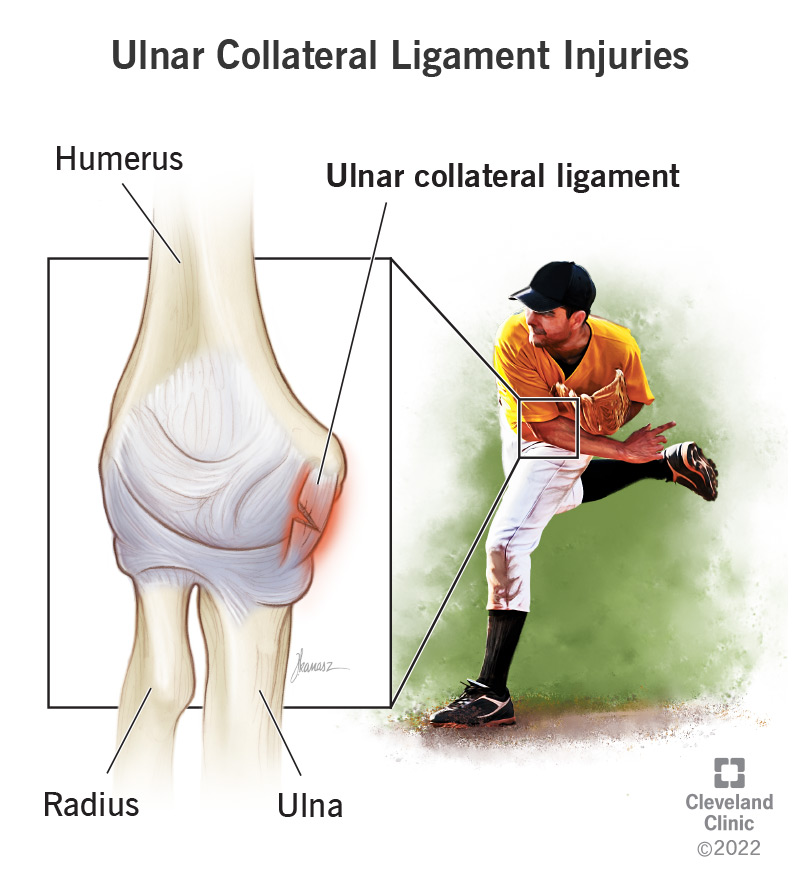Ulnar collateral ligament injury is an inner elbow injury. It’s mainly an overuse injury and is most famously known as a baseball pitcher’s arm injury. But a UCL can happen to anyone who repeatedly uses strenuous overhead arm movements. Symptoms include pain and tenderness at your elbow. Some might feel a sudden pop at the inner elbow.
Advertisement
Cleveland Clinic is a non-profit academic medical center. Advertising on our site helps support our mission. We do not endorse non-Cleveland Clinic products or services. Policy

A UCL injury (Tommy John injury) is an inner elbow injury. It happens when you stretch or tear your ulnar collateral ligament. Your UCL is a strong band of tissue on the pinky finger side of your elbow.
Advertisement
Cleveland Clinic is a non-profit academic medical center. Advertising on our site helps support our mission. We do not endorse non-Cleveland Clinic products or services. Policy
This ligament supports your elbow joint. You use it when you raise your arm to throw something overhead. Overuse is the most common reason why people injure their UCLs.
Ulnar collateral ligament injuries are most common in people who play sports that involve repeatedly throwing a ball or another object overhead. Baseball is a prime example. The injury’s nickname refers to a famous baseball player who recovered from a severe UCL tear after surgery. But anyone who repeatedly uses strenuous overhead arm movements can have a UCL injury.
Healthcare providers characterize ULC injuries by the amount of damage done to your ligament. The classifications or grades of UCL injuries are:
Very rarely, a UCL injury will pull a small piece of bone when the ligament tears away from the bone (avulsion fracture).
Your symptoms depend on whether you stretch or tear your UCL. They may be mild or moderate (Grades 1 and 2) or severe (Grade 3).
You may have a mild to moderate injury if you:
Advertisement
You may have a severe injury if you:
Repetitive stress, falling on your outstretched arm and traumatic injury may lead to a Tommy John injury:
Your healthcare provider (usually an orthopedic specialist or a sports medicine specialist) will review your medical and athletic history. They’ll do a physical examination. They’ll check to see if it hurts when you move your arm or elbow. During the exam, they’ll check:
They may do a valgus stress test to see if your elbow joint is loose.
They may do other imaging tests like:
That depends on your situation. A small tear in your UCL may heal on its own or with nonsurgical treatments. But you may need surgery if you have a severe injury.
Your healthcare provider may recommend PRICEMM to support healing. PRICEMM stands for:
Your orthopedic specialist may recommend platelet-rich plasma injections. This treatment involves injecting platelets from your blood into your ligament. The platelets help your UCL heal.
Surgical treatments are:
Talk to a healthcare provider if you have elbow pain or weakness that affects your ability to make overhead throws. They may refer you to a specialist for tests and treatment. If you’re receiving treatment, let your provider know if your symptoms get worse.
Advertisement
You should expect to be patient and take it easy while your ligament heals. The time it may take to heal depends on your situation. If you need surgery, recovery may take a year. Recovery time may be shorter if you tear your UCL but don’t need surgery. It may be several weeks or months for your ligament to heal.
Proper conditioning, proper elbow movement technique and rest when you feel elbow discomfort can help prevent ulnar collateral ligament injury. In athletes, a pitch count limit and required rest can help protect against injury.
Ulnar collateral ligament injury is an inner elbow injury. It’s mainly an overuse injury and is most famously known as a baseball pitcher’s arm injury. However, it can happen to anyone who repeatedly uses strenuous overhead arm movements. Symptoms include pain and tenderness at your elbow. Some might feel a sudden pop at the inner elbow.
If you’re not an athlete or using repetitive overhead arm movements, your elbow might heal with simple treatments such as rest, ice, medications and physical therapy. Tommy John surgery uses a tendon from another body area or a donor as a replacement ligament. You and your healthcare provider will decide which treatments are best for you based on how severe your injury is and how much you need to use strenuous overhead arm motions.
Advertisement
If an injury puts you on the bench, you want experts by your side. Cleveland Clinic’s sports medicine specialists can get you back in the game.

Last reviewed on 06/19/2025.
Learn more about the Health Library and our editorial process.